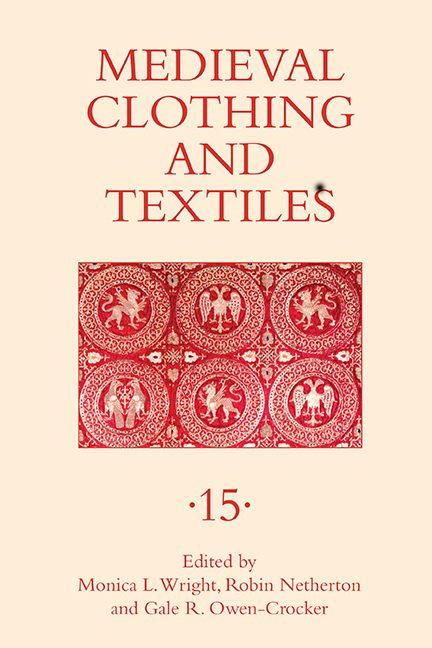Book contents
- Frontmatter
- Contents
- Illustrations
- Tables
- Contributors
- Preface
- 1 Old Rags, New Responses: Medieval Dress and Textiles
- 2 Text/Textile: “Wordweaving” in the Literatures of Anglo-Saxon England
- 3 Unfolding Identities: The Intertextual Roles of Clothing in the Nibelungenlied and Völsunga Saga
- 4 Clothing and Textiles at the Court of King John of England, 1199–1216
- 5 Dressing the Sacred: Medallion Silks and Their Use in Western Medieval Europe
- 6 Habit Envy: Extra-Religious Groups, Attire, and the Search for Legitimation Outside the Institutionalised Religious Orders
- 7 The Loom, the Lady, and Her Family Chapels: Weaving Identity in Late Medieval Art
- Recent Books of Interest
- Contents of Previous Volumes
Preface
Published online by Cambridge University Press: 31 March 2021
- Frontmatter
- Contents
- Illustrations
- Tables
- Contributors
- Preface
- 1 Old Rags, New Responses: Medieval Dress and Textiles
- 2 Text/Textile: “Wordweaving” in the Literatures of Anglo-Saxon England
- 3 Unfolding Identities: The Intertextual Roles of Clothing in the Nibelungenlied and Völsunga Saga
- 4 Clothing and Textiles at the Court of King John of England, 1199–1216
- 5 Dressing the Sacred: Medallion Silks and Their Use in Western Medieval Europe
- 6 Habit Envy: Extra-Religious Groups, Attire, and the Search for Legitimation Outside the Institutionalised Religious Orders
- 7 The Loom, the Lady, and Her Family Chapels: Weaving Identity in Late Medieval Art
- Recent Books of Interest
- Contents of Previous Volumes
Summary
Volume 15 opens with an essay by founding editor Gale R. Owen-Crocker that provides a panoramic overview of the discipline of medieval clothing and textiles. The article affirms the importance of this truly interdisciplinary journal—a unique meeting place for diverse scholars whose academic homes are far afield from one another—for the work of understanding the fabric of the medieval world.
The six essays that follow bear witness to a rich diversity of range in chronology, geography, and discipline.
Maren Clegg Hyer explores the lexical legacy of “wordweaving” in Anglo-Saxon literature. She demonstrates that we must understand the text-textile metaphor found in texts composed in both Old English and Anglo-Latin as reflective of a deep familiarity with the practice of weaving and clothwork in Anglo-Saxon society. She traces this material aspect of literary composition through Anglo-Saxon poetics and through the influence of Greek, classical Latin, and early medieval literature on Old English and Anglo-Latin poets.
Elizabeth M. Swedo focuses on the narrative use of clothing in medieval Germanic literature, analyzing the divergent approaches embraced by the thirteenth-century authors of the Middle High German epic poem the Nibelungenlied and its late-thirteenth-century Old Norse prose counterpart Völsunga saga. Swedo demonstrates how the authors of both works richly employ clothing signifiers and relates the differences to each work's unique cultural milieu.
Hugh M. Thomas probes the purchasing habits of the early-thirteenth-century English King John by examining the close and misae rolls that record the king's chamber and wardrobe. Thomas's work allows a clear picture to emerge of the importance of clothing and textiles at court, whether as personal adornment or as gifts bestowed upon members of the court. The contemporary literature attests to this focus, but as Thomas concludes, history tells a different story.
Tina Anderlini argues that silks with medallion designs were among the most luxurious and desired in Western Europe and relates their appeal to Christian symbolism despite their initial Eastern origin. Assessing the evidence provided by archaeological, textual, iconographical, and visual sources, she suggests that this spiritual connection helps to explain the prevalence of roundels in representations of sacred contexts.
- Type
- Chapter
- Information
- Medieval Clothing and Textiles 15 , pp. xi - xiiPublisher: Boydell & BrewerPrint publication year: 2019

